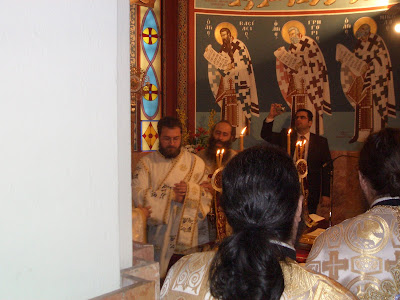

Pelagia's father arrived in Thessaloniki very late on Saturday evening and he hasn't had much time to rest since then! :)
On Sunday morning, we had Liturgy at our local parish of St. George's. Afterward, our parish priest, Fr. Alexios, arranged for a small gathering in the parish center for coffee. He put Fr. Joseph on the spot as everyone was eager to ask him about Orthodoxy in America. One well-known professor of theology from the university, who happens to go to our parish, Prof. Dimitris Tselingidis, also came and made it a lively discussion.
After a brief break for lunch, we then resumed the activities when Fr. Alexios invited us to make a trip out to All Saints Monastery near Vergina, a little over an hour west of Thessaloniki. We took the parish's van and went with one of my best friends, Paris, and Fr. Alexios' spiritual father, Fr. Asterios, his wife, and her twin sister (who is also a presvytera).
The monastery was founded only in 2006, and is built on the site of an old men's monastery, which itself was built on the site of an old chapel from the 11th century. Indeed, that old chapel serves as the monastery's main church. In the top photo, you can see the (new) outside of the church.
In the second photo, you can see the refectory directly opposite the church.


In the third photo, you see the inside of the church. The iconography along the sides dates back to the original chapel (11th century), while the roof and the iconography on it is new.
The final photo is of the Dormition, located just above the entrance to the church. This is part of the original iconography, dating to the 11th century.
The nuns were extremely hospitable to us. There are six nuns and four novices. All of them are quite young, including the abbess, and full of joy and life. Among their other jobs, they make and sell deserts, so we were treated to a beautiful and tasty selection of deserts and coffee.
Afterward, they showed us their workshops. First, was the iconography studio; second was a leather shop, where they specialized in making book covers. I'd never seen this before and their work was quite good. Fr. Joseph left a tiny pocket prayer book of his, that was falling apart, for the sisters to fix. Finally we went to the vestments shop, where Fr. Alexios admired some of the beautiful fabrics (he's quite an afficionado).
As we were leaving, Fr. Paul and Fr. Christodoulos of Mt. Athos arrived. Fr. Paul is the monastery's spiritual father and has devoted countless hours to helping build the monastery, brick by brick. The two of them live by themselves in a cell near Koutloumousiou on Mt. Athos. I was blessed to stay with them when I went the Holy Mountain the first time with Fr. Alexios.
Fr. Alexios told them Fr. Paul that, God willing, I was being ordained a presbyter next Sunday, and he and the sisters made me the very, very generous gift of a beautiful epitrachelion that the sisters had made themselves.
After giving us all jars of their homemade sweets and liquers, we finally managed to leave and head back home. We arrived back around 9:30 or 10:00, where Pelagia and our neighbors, the Lillies, were waiting to have dinner with us. We had a very nice meal and then finally went to bed, exhausted.
Stay tuned...there will be much more in the coming days. For more photos from the monastery click here.





















































